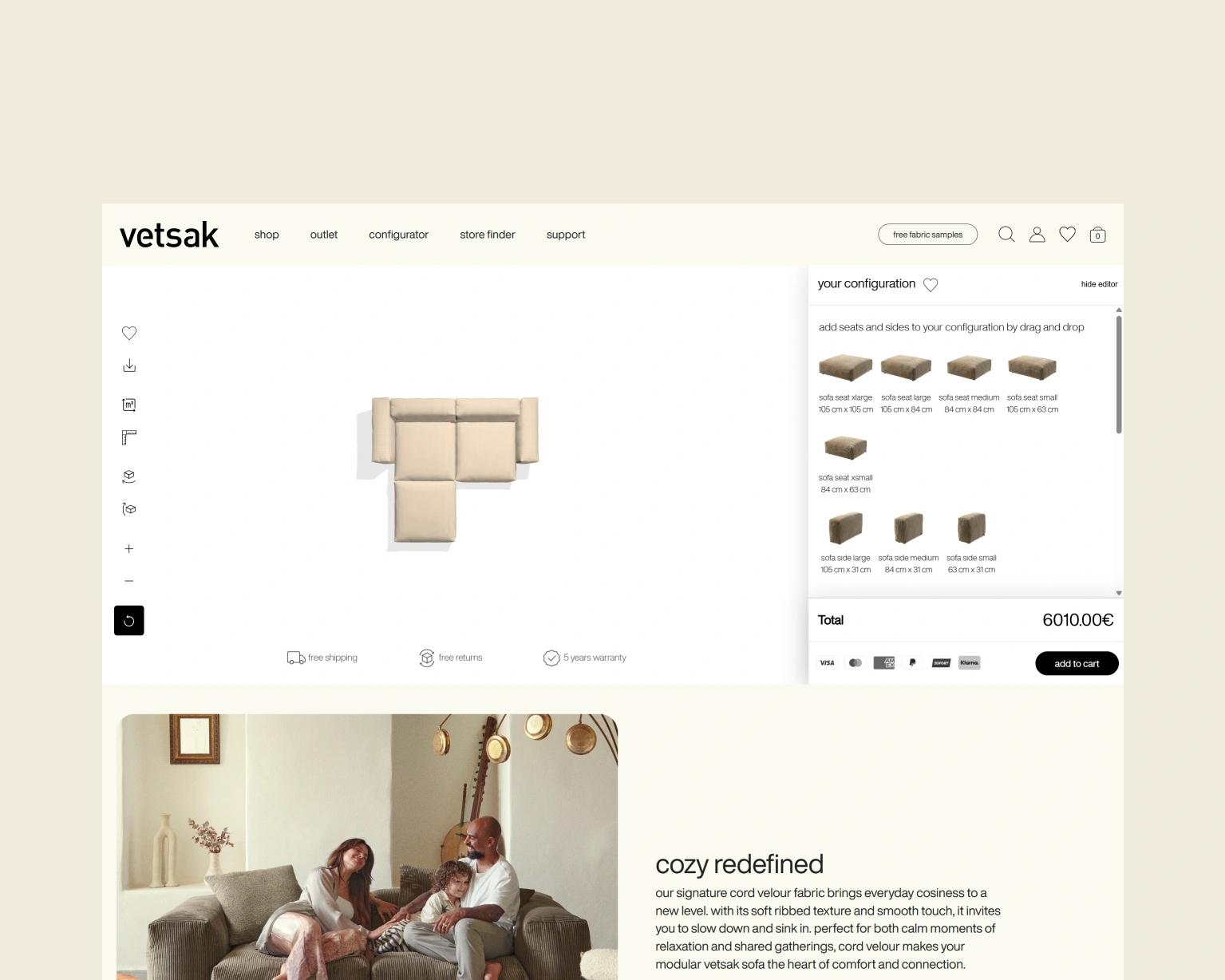Cursor Label

Shopify Plus Development
Book a meeting

They trusted us


















Shopify Plus is the enterprise ecommerce platform version of Shopify, created for large or quickly growing ecommerce stores.
As Shopify Plus allows merchants to run multiple storefronts on multiple domains, and use wholesale options or several currencies in their shop, many well-known brands have decided to either move from their previous platform for Shopify Plus or start there straight away. Currently, there are 24,459 live stores running Shopify Plus – a 37% increase year-over-year in 2021 Q4.

Why do you need it?
01
Bigger customization options
We leverage the open API and Checkout Extensibility for unique, personalized shopping journeys. Gain full control over the user experience and implement advanced solutions, including Headless Commerce architecture.
02
Plenty of automation tools
Utilize exclusive Shopify Plus features like Launchpad to automate product launches, promotions, and marketing actions. Streamline internal processes, manage complex B2B segmentation, and handle multi-market operations efficiently.
03
Faster Speed
We implement cutting-edge technology (e.g., Headless with Hydrogen) for lightning-fast page loading and superior performance. This optimization significantly improves UX and drives higher conversion rates, especially on mobile.
04
Can handle bigger traffic
The Shopify Plus infrastructure is built for massive scalability, reliably handling up to 10,000 orders per minute. Ensure 99.98% uptime and flawless performance during peak sales events like Black Friday and global expansion.

Why is it worth to work with us?
Experience
200+
Relised Shopify projects
Team
50+
Shopfiy Experts in the team
"Their professionalism, commitment, and flexibility made the migration to Shopify Plus and the development of the platform smooth and seamless."
Daria Żornaczuk
E-commerce Specialist

Services & technologies we use
With over 10 years of experience in the field, you’re in good hands with us, as we know exactly just what your business might need for a successful launch. So what are we especially good at?
01
Preparing expansion plans for the new markets
Developing strategic plans for global growth and international expansion, leveraging Shopify Plus tools to set up and manage multiple localized storefronts and currencies across various regions.
02
Developing Shopify B2B and Wholesale shops.
Creating dedicated, highly scalable B2B and Wholesale channels on Shopify Plus, which includes setting up unique pricing, custom accounts, and streamlined processes for business customers.
Learn more
03
Headless E-Commerce
Building decoupled (headless) architecture using Shopify Plus as a powerful backend, providing increased flexibility, faster site speed, and advanced customization options for the storefront.
Learn more
04
Store migration to Shopify
Safe and efficient migration of large-scale, enterprise-class stores from various platforms (np. Magento, Shopware) to Shopify Plus, guaranteeing zero downtime and preventing traffic/SEO loss.
Learn more
05
Optimizing your Shopify for mobile shopping
Improving store performance and usability specifically for mobile users, including the development of Progressive Web Apps (PWA) to ensure an app-like, fast, and highly engaging mobile shopping experience.
06
Creating custom Shopify UX/UI Design
Designing a unique, enterprise-level User Experience (UX) and User Interface (UI), including full customization niedostępnych w standardowym Shopify, takich jak strona checkout.
07
Boosting existing Shopify store performance
Enhancing existing store performance using Shopify Plus capabilities, focusing on increasing speed, stability, and traffic-handling capacity essential for fast-growing businesses.
08
Building custom apps for Shopify stores
Developing bespoke applications and unique solutions specifically for Shopify and Shopify Plus, extending platform functionality to meet complex and non-standard business requirements.Eksportuj do Arkuszy
Learn more
You can also rely on us to monitor your site’s performance and help you whenever you have a problem or question. Our team can suggest tools, apps, and solutions that will boost your site’s growth, as well as take care of regular maintenance and optimization of your store.
Tailored services
for your Business
We know Shopify like the back of our hands. We can clearly assess the time and resources that you need to deliver you the result you want.

How can we help you with Shopify Plus development?
If you need assistance with Shopify migration, then our Shopify Plus experts are here to help. We have a team of 50 Shopify experts, from developers and designers to business analysts, so we can help you both with building, migrating, and expanding your store and also with developing a strategic plan for your shop.
Aside from building and managing stores, we also develop Shopify apps and bespoke solutions for Shopify and Shopify Plus, like Progressive Web App (PAW) stores. Basically, a PWA is a website with all the benefits of an app – it’s faster and more engaging, can work offline and it can even access your camera and microphone.
With our help, you can determine whether PWA is the right solution for your store, move your store safely, see if everything works as it should, and then keep the PWA maintained and optimized.
Why hire Shopify Plus developers from WeCanFly Agency?
As a Shopify Plus-exclusive agency, we are experts in all things related to Shopify. So whether it is launching a new store, migrating it from another ecommerce system, improving store UX, optimizing your store for best performance, or developing custom solutions for Shopify – you can count on us.
We also have a lot of experience when it comes to Shopify Plus implementations – we’ve helped both local brands and large, enterprise-class companies to move their stores to Shopify Plus. Our experienced Shopify experts will help you not just choose the right ecommerce platform and third-party apps but also find the right solution for your unique requirements. We can also integrate your new store with your current tech stack apps, for example, your ERP.
In addition, you do not need to worry about any downtime or traffic loss when moving stores – we have tested the migration process to Shopify Plus Platform from a number of e-commerce platforms like Magento, Shopware, or dedicated e-commerce sites. In just a few weeks, your new store can be up and running without losing your position in the search engine or dealing with worse store performance.
When you might consider getting Shopify Plus?
Shopify Plus is a premium e-commerce solution for large-scale businesses that need more flexibility, customization, and scalability than regular Shopify. It is ideal for multi-channel and wholesale sellers who want to manage multiple stores from one dashboard, access advanced analytics, and create automated scripts. Shopify Plus also allows unlimited staff accounts, inventory locations, and integrations with over 180 social media and online marketplace channels. Moreover, Shopify Plus gives you full control over your store design and checkout process and the ability to offer customer-based pricing and shipping rates. If you are looking for a powerful and reliable e-commerce platform that can handle your growing and complex needs, Shopify Plus might be the right choice for you.
How to get started with Shopify Plus?
While you can open a regular Shopify account virtually straight away just by creating an account on the website, signing up for a Plus account is a bit trickier. For one, Shopify Plus pricing isn’t directly visible on their website – you need to request a quote from the Shopify Plus sales team, and they will calculate your pricing based on your monthly revenue. Once you decide you want a Plus subscription, a smart idea would be to hire a Shopify Partner agency to help you launch your new store and teach you how to use the Plus platform – they will also be there to help you with any questions or issues you might have.
If you already have a Shopify account and are moving to Plus, then your account will be upgraded in about 24 hours. After the migration is finished, you’ll receive an introduction email with a link to join Jumpstart, the merchant onboarding program, and also contact details for the Shopify Plus Priority Support team. You will also get access to the Shopify Experts panel, where you can ask for help or hire a developer for any of your Shopify plus development needs – like a new checkout.
What about migrating your store to Shopify Plus? Here it would be best to ask an agency for help, especially if you have a large amount of data to transfer, specific integrations you want to have, or design requirements.
Which Shopify Plus features are worth checking out?
At first glance, Shopify Plus doesn’t look that much different from regular Shopify. You have the same dashboard, editor, and everything that you can find in the standard plans. But the real difference between Shopify and Shopify Plus is when it comes to the exclusive features available only there. Here are a few of the notable features of Shopify Plus:
New (exclusive!) apps
Standard Shopify store owners can take advantage of around 6000 different apps and integrations available on the Shopify marketplace that cover everything from design to marketing. However, Shopify Plus users have access to some handy apps only available to those with the Plus subscription. To name just a few of those apps that might be incredibly useful for you:
- Transporter through which you can easily migrate customers, orders, and product records straight to Shopify.
- Launchpad that marketers can use to plan and automate important store events, including flash sales, product launches, and campaigns. The campaign will launch on a scheduled date, and your site will revert to what it was after your event. You can later review the success of your event by using the dedicated analytics dashboard.
- Shopify Scripts, with which you can tailor your checkout to your needs. For example, you can use this feature to create unique discount codes for your shoppers or automatically add a freebie to shoppers’ carts. But it has a load of more uses – you can also use it to dynamically change the pricing in your store, run promotions, or help you manage multiple currencies.
- Shopify Flow enables you to automate tasks and processes within your store and across your apps. These make Shopify automatically take specific actions based on certain events (for example, if your inventory is running low, it can send an email message to a supplier).
Special support programs for Plus subscribers
If you choose Shopify Plus, you will also get access to many exclusive programs that are available only for Plus users – for example, Shopify’s Merchant Success Program. This program was created for high-volume merchants who want to grow their stores faster. There, Shopify Experts can answer your questions about running the store or Plus platform, help you with solving third-party apps problems, or find Shopify Plus partners you can work with.
There’s also a special Facebook community for Shopify Plus users and partners, an extensive library of online courses and training videos to guide you through Shopify Plus and a weekly newsletter that’ll keep you updated on the updates and new features. As a Shopify Plus merchant, you will also have access to the Shopify Plus academy, where you can find both quick, practical lessons about the platform as well as comprehensive courses on topics such as paid advertising or expanding internationally. What’s even better is that all your staff members added to the Plus account will have access to those courses as well and for free.
Custom Checkout page
Even though the regular Shopify plan gives you plenty of options when it comes to customizing your store design, there are a few places you can’t change – like your checkout.
Shopify Plus merchants meanwhile can fully customize the default checkout page through the Liquid language. By editing the available checkout file, merchants can add, remove, and reorder content, change styles, colors, and fonts, and generally adjust the look of the checkout page to match the rest of their Shopify store’s branding. Through Shopify Scripts, Plus merchants can also offer customized discount codes or shipping prices based on various factors, such as customer tags, products in the basket, basket value, etc.
If you can’t do it yourself, then you can hire a Shopify Partner to help you with customizing your checkout to match your brand. Being able to reach out to Shopify Plus developers who are all familiar with how to make your store shine is one of the best Shopify Plus benefits out there.
Dedicated wholesale channel
A wholesale channel is another feature that sets apart the Plus subscription from a basic Shopify account. As your company expands, you’ll definitely attract customers who want to buy in bulk – why not give them such an option?
This one Shopify Plus feature allows you to add a separate, password-protected wholesale site based on your online store. There, you can offer wholesale buyers either the same products or special versions at exclusive prices. You can also give them customized lists with special prices, create bundles of products, or add exclusive promotional coupons for them.
How much does Shopify Plus cost, and what’s included in the price?
Regular Shopify subscription offers three flat-rate e-commerce plans which cost $32, $92, and $399 per month ($24, $69, $299 per month – yearly). So no matter how many sales you will have per month, your monthly fee always stays the same. Shopify Plus meanwhile works on a slightly different model.
Shopify Plus charges you based on your monthly sales volume. At least, you can expect to pay $2,500 per month for using Shopify Plus (or $2,300 on a 3-year contract).
You will also need to add a 0.2% transaction fee to your costs if you use a third-party provider for payment processing. However, Shopify Plus merchants who use Shopify Payments pay no transaction fees except for merchants in Austria, Belgium, and Sweden. More info here.
The cost of Plus might seem staggering. For merchants who generate around $1-2 million in annual revenue, though, the dedicated Shopify support and unique features we mentioned above start making the investment worthwhile. What’s more, all Shopify stores work on a hosted platform, meaning you don’t have to worry about paying for hosting, server management, updates, security, and so on – like you would with other popular ecommerce store systems such as Magento.
Check out our Shopify Pricing Calculator to easily compare the available Shopify plans.
How does Shopify Plus compare to other ecommerce platforms like BigCommerce and Magento Commerce?
And while we’re on the topic of comparisons – how does Shopify stack up against Bigcommerce and Magento? Those three names are most likely the ones you hear about the most open if you want to open or migrate your online store and are researching your options now. All of these platforms have long supported small and mid-sized businesses, but they also have products and subscriptions that are made specifically for larger ecommerce businesses.
BigCommerce has BigCommerce Enterprise, and Magento has Magento Commerce or Adobe Commerce Cloud. What are their strong and weak points? Let’s have a quick look at those two platforms.
Magento Commerce
Magento’s strongest point is its flexibility. Since it’s an open-source platform with a free license subscription, you can technically use it for free. You are the main owner of your store code, so you can adapt it to your business however you like. There are also hundreds of online templates you can use to customize your store. Magento also comes with an extensive list of out-of-the-box features that you can use to run your store effectively – and if you need more, you can just download one of the hundreds of extensions available.
However, the main issue here is that Magento isn’t the easiest system to use. As a store owner, you are responsible for everything – from designing and managing the store to managing the host server’s stability and security. If you have web development skills or can ask your company’s technical support to manage the store, then installation, theme customization, and maintenance shouldn’t be much of a problem.
If you don’t have enough time or employees to manage the Magento store yourself, then you should find a Shopify agency that handles the system on your behalf since Magento is a complex platform, and you might not be able to utilize its full potential otherwise. Due to its size, Magento is also quite slow to load. As a result, adding any changes or customizations to the story might be pretty rather tricky – Magento imports data at a very slow rate.
But the biggest problem when it comes to Magento is the costs involved. Yes, the open-source license is free to use – but the costs of hosting, website design and development, security, and SEO are all on your side. Magento also requires using a dedicated server to host it, again because of the platform’s size. With Magento Commerce and Commerce Cloud, the costs grow even more.
Besides the aforementioned development services, you have to consider Magento license costs that are based on a store’s revenue and can cost from $22,000 a year to even over $190,000.
That is why Magento is mainly used by large, enterprise-level companies with their own development teams or a large budget to hire someone to maintain the site.
Interested in learning more about how Shopify Plus and Magento compare? Check out our Shopify Plus vs Magento: 7 key differences article.
BigCommerce
Compared to Magento, BigCommerce is much easier to use. BigCommerce is a hosted e-commerce solution that business owners can use to set up an online store and sell their products on the Internet. A ‘hosted’ website runs on its own servers – you don’t have to purchase web hosting or install anything on your computer to use it. As long as you have a web browser and access to the internet, you can build and manage your store from anywhere.
Unlike Magento, BigCommerce is primarily designed for users without much experience with web design or coding. To start your first online store, you just have to pick one of the BigCommerce templates and create your store through a drag-and-drop page builder. That also means that BigCommerce plans are far more affordable – the pricing starts from $29 a month to $299 for business accounts.
BigCommerce also has a special subscription for Enterprise companies, though to know the exact price for it, you have to request a quote based on your average order value and the average number of orders you process each month.
But there’s a catch to the low cost. The biggest one is that most businesses are forced to upgrade when they reach a certain revenue threshold. Every BigCommerce subscription has a revenue limit, and if companies exceed the limit, they are automatically pushed into a higher-tier package. So, for example, if you are on the cheaper Standard subscription, you can only sell for $50,000 in a year before you get bumped to Plus. For Plus users, the limit is $180,000 a year in sales. Pro users get up to $400,000 in annual sales and pay an extra $150 per month for every additional $200,000 in sales.
The majority of BigCommerce’s templates are also paid for – aside from 12 free templates, prices range from $145 to $235.
Which platform should you pick? If you have a large budget to devote to your ecommerce store and plenty of developer resources to devote to site set-up and maintenance, Magento may be the right choice for you. You’ll be able to design your shop however you like, but you’ll also have to handle everything from hosting to payment security yourself.
With BigCommerce and Shopify, hosting, maintenance, and updates are handled by the providers, so you can focus on growing your store. On BigCommerce though you should keep an eye on the revenue limit if you don’t want to be moved to a more expensive tier.
Conclusion
Shopify Plus might be the best choice for brands that grow quickly or already have millions in revenue. From its ease of use and excellent support to its many notable features you can use to boost your shop, it has everything your shop might need. If you are thinking about starting selling internationally, then migrating to Shopify Plus might also turn out to be your best, as the tools inside the Plus subscription make creating multi-language pages and using multiple currencies easier than ever.
But the price is pretty hefty – so before you migrate, you should have a discussion with your team on whether it’s the right choice to make. Feel free to contact our agency if you have any questions or doubts about the migration as well – we’ll be happy to help you.



